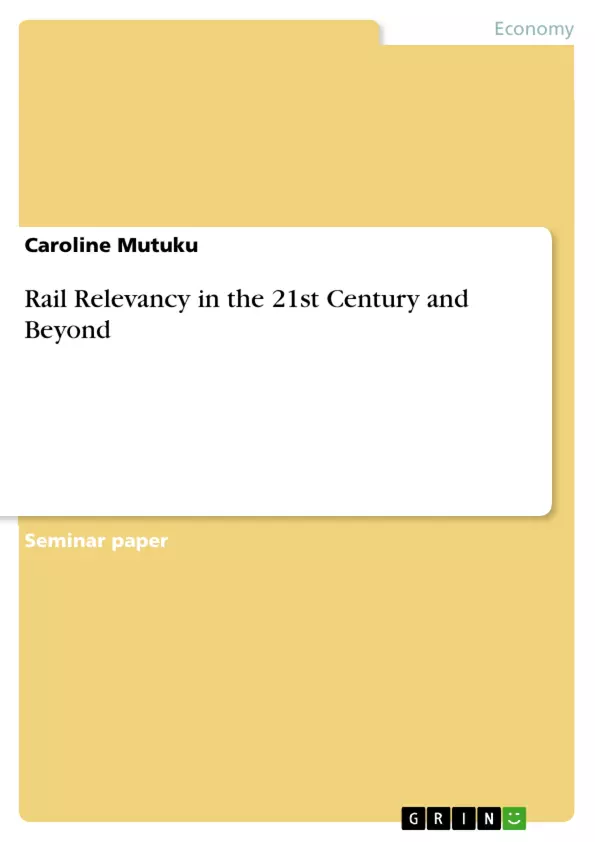Information, goods, and people are moving too fast in this competitive 21st century. In 2005 alone, more than 9.7 billion trips were made through public means. Today, travelers are offered different and competing modes of transportation. The competitive nature of the industry results in the modernization and expansion of every part of the system (APTA, 2007). Rail transport is not left behind.
The Mohawk and Hudson Railroad in New York opened in 1831 as the US first railroad. The objective of the railroad was to supplement Erie Canal travel that runs from Schenectady to Albany. The railroad brought to the nation transport means that had never been seen before. It carried everything from passengers to mail to livestock to many corners of the country. Since then, the United States has seen almost 800 different rail companies blossoming 70 defunct resulting on the question of the sustainability and relevancy of railway in the 21st century.
Inhaltsverzeichnis (Table of Contents)
- Rail Relevancy in the 21st Century and Beyond
- The Evolution of Rail Transport
- The Early Days of Railroads in the US
- Challenges and Critiques
- The Sustainable Mobility Agenda
- Integration of Rail Routes
- The Rise of Modern Rail Systems
- The Park-and-Ride Concept
- The Rise of High-Speed Rail
- Benefits of High-Speed Rail
- Global Adoption of High-Speed Rail
- Economic and Environmental Impacts
- Freight Transportation Cost-Effectiveness
- Environmental Sustainability of Rail Transport
- Climate Change Implications
Zielsetzung und Themenschwerpunkte (Objectives and Key Themes)
This text examines the relevance and sustainability of rail transport in the 21st century. It explores the evolution of rail systems, including the challenges and critiques faced by traditional railroads. The text also delves into the growing importance of rail transport within the sustainable mobility agenda, highlighting the integration of different rail routes and the rise of modern rail systems. It further analyzes the emergence of high-speed rail, its benefits, and its global adoption, including a look at the economic and environmental impacts of rail transportation.
- The evolution and challenges of rail transport in the 21st century
- The sustainability of rail transport compared to other modes
- The emergence and benefits of high-speed rail systems
- The economic and environmental impacts of rail transport
- The role of rail transport in achieving sustainable mobility goals
Zusammenfassung der Kapitel (Chapter Summaries)
- Rail Relevancy in the 21st Century and Beyond: This chapter introduces the topic of rail transport in the modern era, highlighting the increasing demand for efficient transportation solutions in a fast-paced world. It also briefly touches upon the challenges faced by traditional rail systems.
- The Evolution of Rail Transport: This chapter traces the development of rail transport in the United States, beginning with the first railroad and exploring its impact on the nation's transportation infrastructure. It also discusses the challenges and critiques that have arisen over time, including concerns about cost, inflexibility, and limited reach.
- The Sustainable Mobility Agenda: This chapter examines the role of rail transport within the broader context of sustainable mobility. It highlights the advantages of rail transport in terms of energy efficiency and reduced environmental impact, particularly in long-distance travel. The chapter also explores the integration of rail routes and the emergence of modern rail systems, such as commuter and rapid transit systems.
- The Rise of High-Speed Rail: This chapter delves into the increasing adoption of high-speed rail systems around the world, including the United States. It emphasizes the benefits of high-speed rail, such as its speed, efficiency, and ability to carry a large number of passengers. The chapter also discusses the technological advancements that enable high-speed rail operation.
- Economic and Environmental Impacts: This chapter examines the economic and environmental implications of rail transport. It highlights the cost-effectiveness of rail freight transport, particularly for hazardous materials and bulky goods, and analyzes the environmental benefits of rail transport compared to road and air transport. The chapter also explores the relationship between rail transport and climate change, taking into account the energy sources used to power trains.
Schlüsselwörter (Keywords)
This text focuses on the relevance and sustainability of rail transport in the 21st century. Key themes include the evolution of rail systems, the sustainable mobility agenda, the rise of high-speed rail, economic and environmental impacts, and the role of rail transport in addressing climate change. It also explores concepts such as cost-effectiveness, efficiency, energy consumption, carbon emissions, and the integration of different rail routes.
- Arbeit zitieren
- Caroline Mutuku (Autor:in), 2018, Rail Relevancy in the 21st Century and Beyond, München, GRIN Verlag, https://www.hausarbeiten.de/document/430700


